Sensor Sweep: The Mummy, Dune, I am Legend, John Milius
Monday , 1, November 2021 Sensor Sweep 1 CommentFiction (Withnail Books): In the mid-1930s F. Scott Fitzgerald, author of The Great Gatsby, wrote a short story set in medieval France, with a lead character, ‘The Count of Darkness’, based on the young Ernest Hemingway. It also featured a witch cult, drawn from a research source which greatly inspired the work of H.P. Lovecraft. Fitzgerald’s agent, perhaps unsurprisingly, was somewhat nonplussed, but the story was sold for (belated) publication in a magazine. Since then, ‘Gods of Darkness’ has been forgotten by the reading public, and quietly ignored by Fitzgerald’s estate: it has never been included in any collected edition of the author’s work. Indeed to my knowledge it has never been reprinted anywhere… until now.
Great Gatsby, wrote a short story set in medieval France, with a lead character, ‘The Count of Darkness’, based on the young Ernest Hemingway. It also featured a witch cult, drawn from a research source which greatly inspired the work of H.P. Lovecraft. Fitzgerald’s agent, perhaps unsurprisingly, was somewhat nonplussed, but the story was sold for (belated) publication in a magazine. Since then, ‘Gods of Darkness’ has been forgotten by the reading public, and quietly ignored by Fitzgerald’s estate: it has never been included in any collected edition of the author’s work. Indeed to my knowledge it has never been reprinted anywhere… until now.
Cinema (We’ve Got Back Issues): Back 1999, I remember emerging from the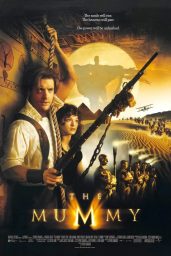 cinema feeling a little nonplussed about The Mumny, Stephen Sommers’ mega budgeted remake of the classic Universal horror movie. As the summer season rumbled on this feeling only grew, after all, why would I give a shit about a CGI stuffed Indiana Jones rip-off when the rest of the period was so damn interesting. Summer alone during 1999 gave us the dizzying highs of The Matrix, the sickening lows of Wild Wild West and the confusing reaction to The Phantom Menace somewhere in between.
cinema feeling a little nonplussed about The Mumny, Stephen Sommers’ mega budgeted remake of the classic Universal horror movie. As the summer season rumbled on this feeling only grew, after all, why would I give a shit about a CGI stuffed Indiana Jones rip-off when the rest of the period was so damn interesting. Summer alone during 1999 gave us the dizzying highs of The Matrix, the sickening lows of Wild Wild West and the confusing reaction to The Phantom Menace somewhere in between.
Tolkien (Murray Ewing): “On Fairy-Stories” is one of those rare windows — along with Lovecraft’s “Supernatural Horror in Literature”, Moorcock’s Wizardry and Wild Romance, and Le Guin’s key essays in The Language of the Night — into the thinking of a major fantasy writer about fantasy itself. They’re often as much (if not more) about what the writer thinks others are doing wrong than how to do it right, and usually end up having to be mined for a few insightful gems — which, though rare, are always well worth the mining.
along with Lovecraft’s “Supernatural Horror in Literature”, Moorcock’s Wizardry and Wild Romance, and Le Guin’s key essays in The Language of the Night — into the thinking of a major fantasy writer about fantasy itself. They’re often as much (if not more) about what the writer thinks others are doing wrong than how to do it right, and usually end up having to be mined for a few insightful gems — which, though rare, are always well worth the mining.
Fiction (Ricochet Reviewer): Robert Neville blockades himself in his home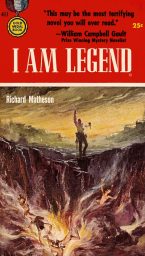 every night to ward off the hordes of vampires that have taken over the world. By day, he slays the undead in their sleep and researches their affliction, never suspecting what he himself is turning into.
every night to ward off the hordes of vampires that have taken over the world. By day, he slays the undead in their sleep and researches their affliction, never suspecting what he himself is turning into.
Cinema (Unz): Denis Villeneuve’s Dune, Part 1 is now in theatres. I can’t recommend it. It isn’t terrible. It is merely mediocre. I found it dull to the eyes, grating to the ears, and a drag on my patience. Villeneuve spends 156 minutes and only gets halfway through the novel. David Lynch told the whole story in 137 minutes. Of course audiences are willing to sit through long movies if they are really good: Peter Jackson’s The Lord of the Rings trilogy, for instance. But this film isn’t in that league.
T.V. (Talking Pulp): I have HBO Max but I didn’t even know this was out there until Joe Rogan was talking to Zuby about it on his podcast. Granted, I also didn’t know what the hell Q was until a few months before the 2020 presidential election when you couldn’t escape mention of it on Twitter, a platform I still use because apparently I’m into torture and pig vomit limited to 280 characters.
RPG (Sorcerers Skull): I’ve again been pondering running Talislanta in Pelgrane Press’ Dying Earth rpg. Why this particular ruleset, which just happens to be based on the work of an author who was a big influence on Talislanta (particularly when there’s another Dying Earth game on the way, after all)? Well, attempting to emulate its source material, it discourages combat and killing and encourages social interaction and trickery.
Pelgrane Press’ Dying Earth rpg. Why this particular ruleset, which just happens to be based on the work of an author who was a big influence on Talislanta (particularly when there’s another Dying Earth game on the way, after all)? Well, attempting to emulate its source material, it discourages combat and killing and encourages social interaction and trickery.
Comic Books (Paperback Warrior): Gerry Conway (b. 1952) is a prolific comic book and screenplay writer. On screen, Conway has written or produced countless shows ranging from G.I. Joe to Perry Mason. In comics, he authored DC’s Justice League of America for eight years and helped create the Punisher character for Marvel. I’ve seen and read a lot of Conway’s work, but I wanted to try one of his text-only short stories. Thankfully, I found one called “Demons in Darkness”. It was published in the fifth issue of Dracula Lives! (1985). This was a magazine published by Marvel Comics imprint Curtis. The story includes frightening artwork by Pablo Marcos (The Mighty Thor, The Avengers).
produced countless shows ranging from G.I. Joe to Perry Mason. In comics, he authored DC’s Justice League of America for eight years and helped create the Punisher character for Marvel. I’ve seen and read a lot of Conway’s work, but I wanted to try one of his text-only short stories. Thankfully, I found one called “Demons in Darkness”. It was published in the fifth issue of Dracula Lives! (1985). This was a magazine published by Marvel Comics imprint Curtis. The story includes frightening artwork by Pablo Marcos (The Mighty Thor, The Avengers).
Cinema (Talking Pulp): Film Review: The House of the Seven Gables (1940)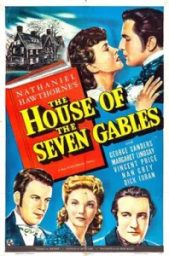 I’ve always wanted to see this movie but it’s just evaded me over the years. It was streaming on something I have, though, so I figured it was as good of a time as any to finally check it out. Man, Vincent Price is super young in this. The only other film that I have seen where he’s actually younger is The Invisible Man Returns, which is from January of the same year. He’s also invisible throughout that picture.
I’ve always wanted to see this movie but it’s just evaded me over the years. It was streaming on something I have, though, so I figured it was as good of a time as any to finally check it out. Man, Vincent Price is super young in this. The only other film that I have seen where he’s actually younger is The Invisible Man Returns, which is from January of the same year. He’s also invisible throughout that picture.
Magazines (DMR Books): The cover for the July, 1969 issue of Magazine of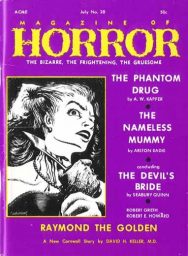 Horror is by Robert Schmand. It’s not as stylish as the Virgil Finlay covers of the past two issues, but it’s suitably gruesome. The Editor’s Page In a review of Stand on Zanzibar by John Brunner in Fantasy and Science Fiction, Judith Merril asks “Is it possible for a writer in one culture fully and adequately to project the mores and emotional responses of realistic human beings in a (realistically) different environment?”
Horror is by Robert Schmand. It’s not as stylish as the Virgil Finlay covers of the past two issues, but it’s suitably gruesome. The Editor’s Page In a review of Stand on Zanzibar by John Brunner in Fantasy and Science Fiction, Judith Merril asks “Is it possible for a writer in one culture fully and adequately to project the mores and emotional responses of realistic human beings in a (realistically) different environment?”
Graphic Novel (Paperback Warrior): James Steranko (b. 1938) could be considered a true Renaissance man. Early in his life he became a talented illusionist, magician and musician. By 1966, Steranko’s comic book pursuits led to the iconic Stan Lee and Jack Kirby of Marvel Comics. He penciled and inked issues of Strange Tales, Nick Fury, Captain America, X-Men, etc. In 1969, Steranko began painting covers for paperbacks and pulps, including Wildcat O’ Shea and The Shadow. In 1976, Steranko’s love of crime-noir and pulp-fiction led to a graphic novel called Chandler: Red Tide.
Interview (Bedlam Files): A book of interviews, conducted by extreme personality enthusiast Nat Segaloff, with the famous screenwriter/director John Milius. Truthfully I’ve always found Milius to be something of a blowhard, a California bred Jewish intellectual who feels the need to maintain, and constantly remind us of, a hyper-macho orientation. You can be sure that in any interview Milius gives he’ll make numerous references to his gun collection and love of all things military.
personality enthusiast Nat Segaloff, with the famous screenwriter/director John Milius. Truthfully I’ve always found Milius to be something of a blowhard, a California bred Jewish intellectual who feels the need to maintain, and constantly remind us of, a hyper-macho orientation. You can be sure that in any interview Milius gives he’ll make numerous references to his gun collection and love of all things military.
Review (Nik-Write a lot): Sharpe’s Assassin is Bernard Cornwell’s twenty-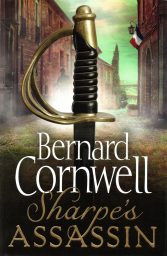 second Sharpe novel (number 21 in his timeline/chronological sequence), his first Sharpe book in fourteen years. This tale follows immediately after Sharpe’s Waterloo (1990). Needless to say, we know Sharpe survives, since he appears in Sharpe’s Devil (1992) which takes place some five years after Waterloo. At Waterloo Sharpe lost a number of his chosen men and the story begins with our two heroes, Patrick Harper and Sharpe burying Daniel Hagman. He is summoned by the Duke of Wellington.
second Sharpe novel (number 21 in his timeline/chronological sequence), his first Sharpe book in fourteen years. This tale follows immediately after Sharpe’s Waterloo (1990). Needless to say, we know Sharpe survives, since he appears in Sharpe’s Devil (1992) which takes place some five years after Waterloo. At Waterloo Sharpe lost a number of his chosen men and the story begins with our two heroes, Patrick Harper and Sharpe burying Daniel Hagman. He is summoned by the Duke of Wellington.
Fiction (Rough Edges): Regular readers of this blog know that I have a great fondness for good, old-fashioned secret agent yarns of the type that were so popular during the Sixties and Seventies. I also enjoy nautical adventures. Throw a little history in, too, and I’m a very happy reader. That explains why I thoroughly enjoyed THE NORTH ATLANTIC PROTOCOL by Jamie Mason.
fondness for good, old-fashioned secret agent yarns of the type that were so popular during the Sixties and Seventies. I also enjoy nautical adventures. Throw a little history in, too, and I’m a very happy reader. That explains why I thoroughly enjoyed THE NORTH ATLANTIC PROTOCOL by Jamie Mason.
Games (Indian Express): Devolver Digital has released a new gameplay trailer for their much-anticipated Western RPG title – Weird West. First showcased at the Devolverland Expo last year, the game gained its initial hype due to the involvement of Raphael Colantonio (creator of Dishonored and Prey) as the creative director.
Review (DMR Books): Meet Mad Amos Malone. A man larger than most, with a knowledge that belies his disheveled appearance. His horse, Worthless, is an excellent companion, but not to be underestimated. Mad Amos Malone always leaves things better than how he finds them. This book just showed up in my feed one day on social media. The premise reminded me a lot of Wellman’s Silver John series and Drake’s Old Nathan stories.
with a knowledge that belies his disheveled appearance. His horse, Worthless, is an excellent companion, but not to be underestimated. Mad Amos Malone always leaves things better than how he finds them. This book just showed up in my feed one day on social media. The premise reminded me a lot of Wellman’s Silver John series and Drake’s Old Nathan stories.
Review (Western Fiction Review): When the Civil War was over, the regular soldiers of the blue and gray returned to the peaceful lives they had known before. Not so for Win and Joe Coulter, members of Quantrill’s Raiders, the most brutal gang of Yankee hatin’ cutthroats ever assembled. They returned not as heroes, but as wanted men. Now they’re committed to a lifetime on the edge – experts with guns, with women, and with keeping just ahead of the hangman’s rope…
Pulp (Pulp Flakes): The Story-Teller is a British pulp, described by Mike Ashley as “the best all-round all-fiction magazine of its day” in The age of the story-tellers, his survey of British fiction magazines. This issue, from 1924, is from around the middle of the magazine’s run from 1907 to 1936. The editor was Newman Flower of Cassell and Co., the publishers. There are big names in this issue – G.K. Chesterton with an instalment of Tales of the Long Bow and Sax Rohmer is represented by his occult detective Paul Harley while Frank Shaw (the British equivalent of the prodigious H. Bedford-Jones) contributes three stories under different names.
Pulp (Bloody Spicy Books): I was the perfect age for The Shadow in 1994. I had been poised (brainwashed) by Hollywood to lap up the glamorous adventure of arguable the most famous of the old-school Pulp Heroes. I was four-years old in the theater mesmerized by Tim Burton’s “Batman,” then I got caught up in Dick Tracy fever the following year. Then more Batman and The Rocketeer plus the discovery of Indiana Jones.
Autobiography (Bedlam Files): In this tell-all, the now 70-year-old Peterson reveals that becoming Elvira wasn’t something she planned for, nor initially took too seriously. She, at age thirty, was simply looking for acting work, and turned up at a 1981 audition being held by a Los Angeles TV station with an extensive B-movie library. Nobody was prepared for how famous the character would become, with a slew of public appearances and endorsements that were lucrative enough to buy Peterson a Hollywood Hills mansion and allow her to self-finance a movie.
reveals that becoming Elvira wasn’t something she planned for, nor initially took too seriously. She, at age thirty, was simply looking for acting work, and turned up at a 1981 audition being held by a Los Angeles TV station with an extensive B-movie library. Nobody was prepared for how famous the character would become, with a slew of public appearances and endorsements that were lucrative enough to buy Peterson a Hollywood Hills mansion and allow her to self-finance a movie.
Lovecraft (Tentaculii): The new Arthur Harris letters (found in the new revised/expanded edition of the Lovecraft-Kleiner letters) reveal the exact details of the British historical survey books which Lovecraft so enjoyed in the mid-1930s. He found four of this set at 10 cents each, while browsing for bargains before Christmas 1934 in the Providence branch of the Woolworth Store.
D&D (Skulls in the Stars): Hey, you know what I haven’t done in a while?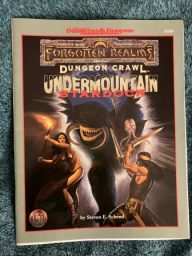 Compile my old school Dungeons & Dragons twitter threads into a post! So here we go…
Compile my old school Dungeons & Dragons twitter threads into a post! So here we go…
Undermountain: Stardock (1997), by Steven E. Schend. I bought this one specifically because I thought I might adapt it’s plot into one of my own campaigns in the future!
History (Sagas from the Sea): In my final undergraduate year, I studied the work of JRR Tolkien, and it acted like a violent intellectual catalyst, for it was here that I first discovered Old English, Icelandic and Scandinavian literature, mythology, poetry and history. It was a gateway into a previously hidden world, and I was instantly hooked. I ransacked the campus library for anything I could find, and I devoured every scrap.
History (SF Gate): JERUSALEM (AP) — An Israeli scuba diver has salvaged an ancient sword off the country’s Mediterranean coast that experts say dates back to the Crusaders.
Israel’s Antiquities Authority said Monday the man was on a weekend dive in northern Israel when he spotted a trove of ancient artifacts that included anchors, pottery and a meter-long (yard-long) sword.
More corporate IP like Star Wars please.